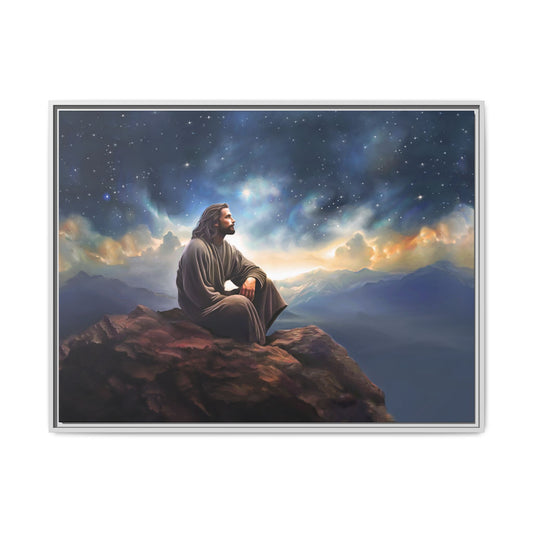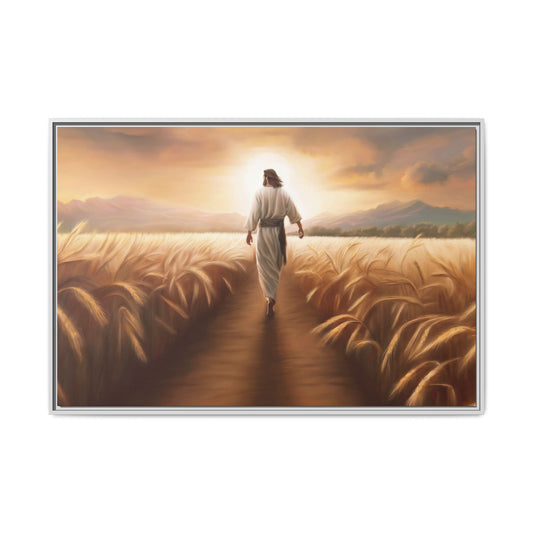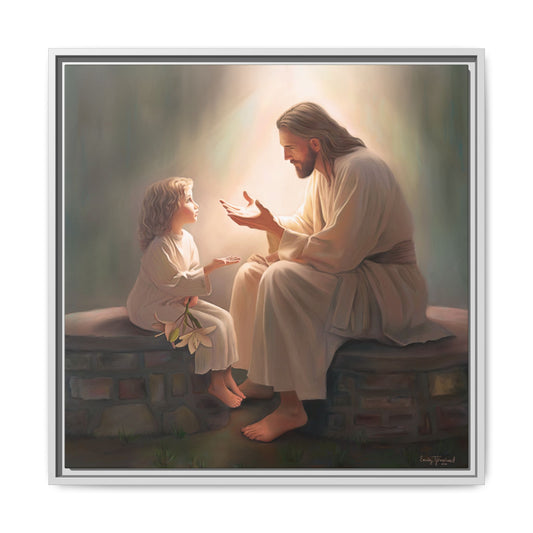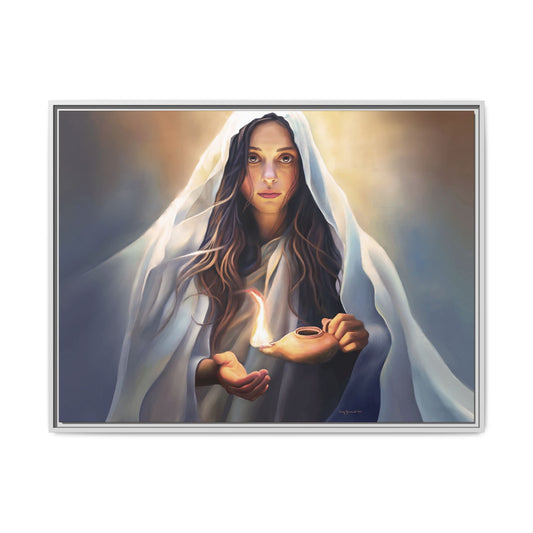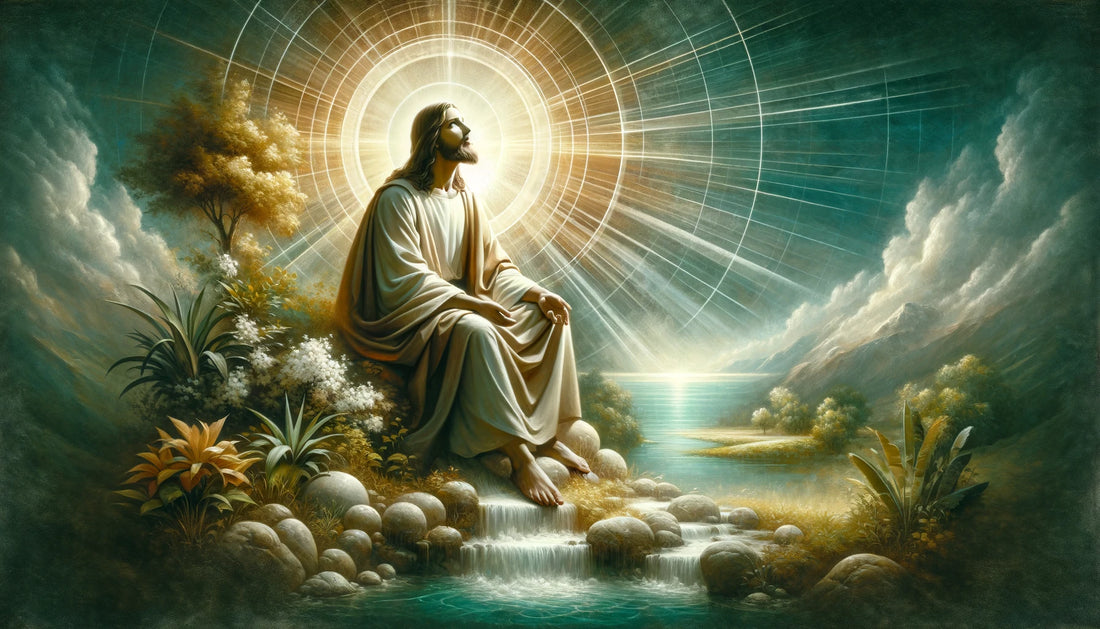
What Is the Meaning of Jesus Sitting Down in Art?
Share
As we explore the world of religious art, it's intriguing to note that Jesus is depicted sitting down in a significant 47% of artworks featuring him. The posture of Jesus sitting down holds deep theological and symbolic meaning, shedding light on his divine authority and role as the judge of the earth.
 But what does this portrayal truly signify? Join us as we uncover the profound implications of Jesus sitting down in art and go deeper into the rich symbolism that unveils layers of interpretation, offering insight into the spiritual and theological significance of this representation.
But what does this portrayal truly signify? Join us as we uncover the profound implications of Jesus sitting down in art and go deeper into the rich symbolism that unveils layers of interpretation, offering insight into the spiritual and theological significance of this representation.
Key Takeaways
- Jesus sitting at the right hand of God signifies his position of authority and power.
- Jesus' sitting at the right hand of God is a fulfillment of Old Testament prophecies.
- Jesus standing at the right hand of God indicates a time for judgment to fall and his enemies to be defeated.
- Jesus' standing in the book of Revelation emphasizes his role as the judge of the earth and foreshadows the coming judgment upon the world.
What is the Meaning of Jesus Sitting Down in Art?
As we consider the meaning of Jesus sitting down in art, it's important to recognize the significance of Jesus' portraits in Christian worship. Capturing different aspects of Jesus' life, including him sitting down, adds depth and richness to the portrayal of his humanity and divinity. It's worth the mention that Jesus also invited others to sit down. What significance, if any, does this invitation mean in our own lives?Brief explanation of the significance of Jesus portraits and their role in Christian worship
Jesus sitting down in art holds significant symbolism in Christian worship, representing his position of authority and power as the judge of the earth. Portraits of Jesus sitting:- Serve as a reminder of his role as the ultimate judge, as depicted in the Bible.
- Encourage reverence and contemplation of Jesus' authority and fairness in judgment.
Importance of capturing different aspects of Jesus' life, including Jesus sitting down
Capturing different aspects of Jesus' life in art, including his seated posture, holds significant importance in portraying his divine authority and role as the ultimate judge in Christian worship. Depicting Jesus sitting down in art allows believers to contemplate his teachings, compassion, and the moments of rest and reflection throughout his life. It offers a holistic representation of Jesus, showing the various dimensions of his humanity and divinity. By including Jesus sitting in art, we emphasize the significance of his earthly life, displaying moments of humility, teaching, and connection with humanity. These portrayals remind us of Jesus' understanding and empathy towards our human experiences, reinforcing the idea that he can relate to our challenges and struggles. As a result, these artworks serve as a powerful visual aid for believers, encouraging them to seek solace in Jesus during their own moments of sitting and reflection.
By including Jesus sitting in art, we emphasize the significance of his earthly life, displaying moments of humility, teaching, and connection with humanity. These portrayals remind us of Jesus' understanding and empathy towards our human experiences, reinforcing the idea that he can relate to our challenges and struggles. As a result, these artworks serve as a powerful visual aid for believers, encouraging them to seek solace in Jesus during their own moments of sitting and reflection.
Jesus Also Asked Others to Sit Down
Discussing the diverse aspects of Jesus' life, including his seated posture, is crucial in portraying his divine authority and role as the ultimate judge in Christian worship. It provides an in-depth analysis of Jesus sitting at the right hand of God, standing in certain instances, and the postponement of judgment. Furthermore, it examines the portrayal of Jesus instructing people to sit down and the abundance of grass in a particular location, offering a comprehensive overview of the various aspects of Jesus sitting and their representation in art. This exploration sheds light on the profound spiritual and theological meanings conveyed through the depiction of Jesus sitting in art.
The Representation of Jesus Sitting Down in Art
When examining the representation of Jesus sitting down in art, we'll explore the historical and religious significance attached to this imagery. We'll also look into the symbolic meanings associated with Jesus sitting down, such as authority, rest, and discipleship. Additionally, we'll visit some of the varied artistic interpretations of Jesus sitting down in different art forms, including paintings, sculptures, and stained glass.Historical significance of Jesus sitting down in religious art
The representation of Jesus sitting down in religious art holds significant historical and symbolic meaning. When Jesus is depicted sitting in religious art, it symbolizes his position of authority and power, as well as his role as the judge of the earth. This imagery is often a fulfillment of Old Testament prophecies and emphasizes Jesus' authority and power. In contrast, Jesus standing in religious art signifies a time for judgment to fall and foreshadows the coming judgment upon the world. The historical significance of Jesus sitting down in religious art reflects his role as the judge, as well as the fulfillment of prophecies. This representation serves as a reminder of Jesus' ultimate authority and the impending judgment, while also providing comfort and assurance to believers.Symbolic meanings associated with Jesus sitting down, such as authority, rest, and discipleship
Jesus sitting down in religious art carries symbolic meanings that encompass authority, rest, and discipleship. The act of sitting often signifies authority in many cultures, and in the case of Jesus, it represents his divine authority as the Son of God. It symbolizes his role as the ultimate authority over all creation. Additionally, Jesus sitting also conveys the concept of rest, reflecting the biblical idea of finding rest and peace in Him. This aspect of sitting down can also be linked to discipleship, as Jesus often sat to teach his disciples, emphasizing the importance of learning and being in his presence. Therefore, the depiction of Jesus sitting in art serves as a powerful symbol of his authority, the rest he provides, and the call to discipleship and learning from him.
Different artistic interpretations of Jesus sitting down in various art forms (paintings, sculptures, stained glass, etc.)
Artists have depicted Jesus sitting down in various art forms, such as paintings, sculptures, and stained glass, each offering unique interpretations of this significant image.- Paintings:
- Some paintings portray Jesus sitting with a sense of calm and contemplation, evoking a feeling of peace and serenity.
- Other paintings depict Jesus sitting in a position of authority, conveying a sense of power and sovereignty.
- Sculptures and Stained Glass:
- Sculptures often capture Jesus sitting with intricate details, emphasizing his humanity and compassion for humanity.
- Stained glass art showcases Jesus sitting amidst vibrant colors, creating a striking visual representation of his divine presence.
The Biblical Basis of Jesus Sitting Down
Let's explore the biblical basis of Jesus sitting down, examining the significance of these moments in his ministry and teachings. By analyzing the specific passages that depict Jesus sitting, we can gain insight into his divine nature and the message he intended to convey. This discussion will shed light on the deeper meanings behind Jesus' actions and provide a deeper understanding of his role and mission.
Examination of biblical passages that depict Jesus sitting down
An important aspect of biblical passages that depict Jesus sitting down is the significance of his position at the right hand of God. This position signifies Jesus' authority and power, as well as the impending judgment upon his enemies. Additionally, the portrayal of Jesus sitting at the right hand of God fulfills Old Testament prophecies, emphasizing his divine role. Furthermore, Jesus' standing in specific instances, such as when Stephen saw him or in the book of Revelation, symbolizes impending judgment and his authority as the ultimate judge. This depiction provides assurance for believers and underscores the gravity of Jesus' role as the judge of the earth. The biblical passages depicting Jesus sitting down convey profound theological truths and serve as a reminder of his ultimate authority and sovereignty.
Analysis of the significance of these moments in Jesus' ministry and teachings
The significance of these moments in Jesus' ministry and teachings, particularly in relation to his sitting down, holds profound theological and eschatological implications. Jesus' ministry was characterized by compassion, humility, and servanthood. His act of instructing the people to sit down before performing the miracle of feeding the five thousand exemplifies his care for their physical needs. This moment emphasizes Jesus' teachings on love, generosity, and provision. Additionally, the act of sitting down with his disciples during the Last Supper symbolizes his role as a teacher, imparting essential lessons and instructions. Furthermore, Jesus' posture of sitting during significant events underscores his authority and wisdom, reflecting his teachings on the kingdom of God and the principles of righteousness. Through these actions, Jesus exemplified humility, compassion, and servanthood, providing an example for his followers to emulate in their ministries and teachings.Connection between Jesus sitting down in the Bible and his divine nature
Reflecting on Jesus' posture of sitting during significant events, we can see a profound connection between his sitting down in the Bible and his divine nature, shedding light on the Biblical basis of Jesus sitting down. The Bible provides insightful instances where Jesus' posture of sitting holds deep significance:- Jesus' Sitting at the Right Hand of God
- Signifies his position of authority and power
- Indicates the coming judgment when his enemies are defeated
- Jesus Standing in Revelation
- Emphasizes his role as the judge of the earth
- Foreshadows the impending judgment upon the world

Jesus Sitting Down as a Symbol of God's Rest
As we consider the symbolism of Jesus sitting down as a representation of God's rest, we can explore the theological concept of God's rest and its connection to Jesus' posture. This discussion can provide insight into how Jesus' rest can offer comfort and peace to believers. In the midst of life's busyness, it's important for Christians to find rest in Jesus and embrace the tranquility that comes from his presence.Exploration of the theological concept of God's rest and its connection to Jesus sitting down
Jesus sitting down at the right hand of God signifies his position of authority and power, symbolizing a state of rest and completion in his role as the ultimate judge. Understanding the theological concept of God's rest and its connection to Jesus sitting down allows us to grasp the significance of this imagery.- Rest in creation: Jesus' sitting down mirrors God's rest after creating the world, conveying the completion of his redemptive work.
- It exemplifies God's rest on the seventh day, signifying the fulfillment of His plan for salvation.
- It represents Jesus' finished work on the cross, providing rest for all who believe in him.
Discussion of how Jesus' rest can provide comfort and peace to believers
After exploring the theological concept of God's rest and its connection to Jesus sitting down, we can find comfort and peace as believers by understanding the significance of Jesus' rest and its impact on our lives. Jesus' act of sitting down represents a completion of His work and a sense of rest and peace, which can bring solace to our hearts. In art, this portrayal of Jesus sitting can serve as a reminder of His finished work and the peace He offers to all who believe in Him. By meditating on the representation of Jesus sitting in art, we can find reassurance and tranquility in our faith, knowing that He's overcome the world and offers us His peace. This understanding can bring comfort and peace to our souls, especially during times of difficulty and uncertainty.
Encouragement for Christians to find rest in Jesus amidst the busyness of life
Let's find rest in Jesus amidst life's busyness by reflecting on the symbol of God's rest portrayed through Jesus sitting down. As Christians navigating the demands of daily life, we can draw encouragement from Jesus' posture of rest and authority.- Jesus invites us to find rest in Him, offering solace from the busyness of our lives
- In the midst of chaos, Jesus provides a calming presence, a place of refuge and peace
- Jesus' act of sitting down exemplifies God's rest and assures us of His sovereignty over every aspect of our lives
- His rest serves as a reminder that we can find tranquility and renewal in Him, regardless of our circumstances
Jesus Sitting Down as a Model for Discipleship
As we explore the topic of 'Jesus Sitting Down as a Model for Discipleship', we'll examine the profound interactions that Jesus had with his disciples while in a seated position. These encounters are rich with lessons and teachings that convey important principles for believers to emulate. By observing Jesus' posture and his interactions with his disciples, we can glean valuable insights and practical applications for cultivating a posture of learning and humility as his followers.Explanation of Jesus' interactions with his disciples while sitting down
Jesus' seated interactions with his disciples serve as a powerful model for discipleship, illustrating the depth and intimacy of his teachings.- Jesus sat down to teach, displaying humility and accessibility to his disciples. This act exemplified the value of creating a welcoming and approachable environment for learning and growth.
- Jesus also sat down to share meals with his disciples, fostering a sense of community and togetherness. This emphasized the importance of fellowship and the unity of believers in serving others.

Discussion of the lessons and teachings conveyed through these encounters
Exploring the lessons and teachings conveyed through these encounters, we gain valuable insights into the model of discipleship exemplified by Jesus while sitting down. In the context of the church and the gospel, these encounters emphasize the importance of humility, servanthood, and compassion. From the scripture, we learn that Jesus, despite his authority, chose to sit down and serve others, setting an example for us to follow. This model of discipleship encourages us to prioritize serving others over seeking positions of power and prestige.Application of Jesus' posture as a model for believers to cultivate a posture of learning and humility
Believers can embrace Jesus' posture of sitting down as a model for cultivating a posture of learning and humility in their discipleship journey.- Learning:
- Emulate Jesus' posture of sitting down to impart wisdom and knowledge, indicating a humble and teachable attitude.
- By adopting this posture, believers can demonstrate a willingness to listen and learn from others, fostering a spirit of receptiveness and growth.
- Humility:
- Jesus' choice to sit down reflects humility and servanthood, encouraging believers to approach discipleship with a humble heart.
- Cultivating a posture of humility enables individuals to serve others selflessly, mirroring Jesus' example of compassion and grace.
Jesus Sitting Down as a Representation of Authority and Majesty
As we explore the meaning of Jesus sitting down as a representation of authority and majesty, we can examine how his posture conveys his sovereignty and power. Understanding Jesus as the King of Kings who reigns from a position of authority provides us with a profound insight into his role as the ultimate ruler. This discussion encourages believers to submit to Jesus' lordship and sovereignty, recognizing his unmatched authority and majesty.
Examination of Jesus' authority and majesty conveyed through his sitting posture
Sitting at the right hand of God, Jesus embodies authority and majesty, symbolizing his position of power and judgment over all creation.- Jesus' sitting posture reflects his supreme authority, conveying a sense of calm and control in all situations.
- This sitting position signifies his sovereignty over heaven and earth, inspiring awe and reverence.
- It also represents his role as the ultimate judge, instilling a deep sense of trust and confidence in his righteous judgment.
Understanding Jesus as the King of Kings who reigns from a position of power and authority
Jesus' sitting posture reflects his supreme authority, conveying a sense of calm and control in all situations, thus signifying his sovereignty over heaven and earth and inspiring awe and reverence. As the King of Kings, Jesus reigns from a position of power and authority, symbolizing his divine rulership over all. His kingly authority is evident in his ability to judge both believers and unbelievers with fairness and justice. This portrayal of Jesus as the ultimate King emphasizes his role as the judge of the earth, underlining his authority and power. Understanding Jesus as the King of Kings who reigns from a position of authority enables us to find comfort and assurance in his role as our advocate and mediator before God. As we serve others, we recognize Jesus' authority and majesty, finding inspiration in his unchanging and everlasting kingship.Encouragement for believers to submit to Jesus' lordship and sovereignty
Believers are encouraged to willingly submit to the lordship and sovereignty of Jesus, embracing His authority and majesty as the ultimate King of Kings.- We find fulfillment in surrendering to Jesus' lordship, recognizing His rightful place as the supreme ruler over our lives.
- Surrendering to Jesus' sovereignty brings peace, purpose, and direction to our lives, aligning us with His perfect will.
- Embracing Jesus' authority allows us to experience the abundant life He promises, as we trust in His wisdom and guidance.
- Acknowledging Jesus as the ultimate King of Kings empowers us to live victoriously, secure in His loving care and provision for our every need.

Jesus Sitting Down and the Christian's Response
As believers, we're called to reflect on the impact of Jesus sitting down on our personal faith and worship. His position at the right hand of God should inspire us to approach God with reverence and awe, recognizing His authority and majesty. Incorporating the representation of Jesus sitting down into our personal worship and meditation can deepen our connection with Him and enhance our understanding of His role in our lives.Reflection on the impact of Jesus sitting down on personal faith and worship
Reflecting on the impact of Jesus sitting down on personal faith and worship, we can contemplate the significance of his position at the right hand of God and its implications for our lives as believers. As we consider this, we're reminded of the following points:- Jesus' sitting at the right hand of God signifies his authority and power, offering us reassurance and confidence in our faith journey.
- This position also represents his role as the ultimate judge, emphasizing the importance of our commitment to him and the righteousness of our actions.
- Jesus' posture encourages us to seek a deeper relationship with him, aligning our lives with his teachings and serving others with love and compassion.
Discussion of how Jesus sitting down can inspire believers to approach God with reverence and awe
Approaching God with reverence and awe is inspired by Jesus' sitting at the right hand of God, signifying His authority and power, and challenging us to align our lives with His teachings. When we contemplate Jesus' posture in art, we're reminded of His sovereignty and the need for us to approach Him with humility and respect. His seated position represents a call to approach God with a heart of reverence, acknowledging His majesty and holiness. We're encouraged to come before Him with awe, recognizing His supremacy and our dependence on His grace and mercy. As we meditate on Jesus sitting in art, we're prompted to approach God with a deep sense of respect and honor, acknowledging His rightful place as the ultimate authority in our lives.
Practical suggestions for incorporating the representation of Jesus sitting down in personal worship and meditation
Let's consider ways to incorporate the representation of Jesus sitting down in personal worship and meditation to deepen our connection with Him.- Reflective Contemplation
- Prayer and Worship
Conclusion
As we conclude our exploration of Jesus sitting down in art, we can appreciate the multifaceted significance of this posture in Christian theology and its representation in visual depictions. The various aspects covered in the article have shed light on Jesus' authority, power, and role as the ultimate judge. Reflecting on the meaningfulness of Jesus' posture in art can deepen our understanding of faith and invite us to engage with visual representations of Jesus in our spiritual journey.
Recapitulation of the different aspects covered in the article related to Jesus sitting down
The different aspects covered in the article related to Jesus sitting down provide a comprehensive understanding of his role as the judge and the fulfillment of prophecies. In art, Jesus sitting at the right hand of God signifies his position of authority and power, as well as the impending judgment upon his enemies. His standing in specific instances, such as when Stephen saw him or in the book of Revelation, also symbolizes the imminent judgment and his authority as the judge of the earth. Additionally, the postponement of judgment due to Saul's conversion highlights the dispensation of grace and the spread of the gospel. Ultimately, Jesus' role as the judge, as depicted in various artistic representations, serves as a reminder of the fair and just judgment that believers and unbelievers will face based on their acceptance or rejection of him as Savior.
Final thoughts on the meaningfulness of Jesus' posture and its representation in Christian art
Recapping the different aspects related to Jesus sitting down in the previous subtopic, we can now draw final thoughts on the meaningfulness of Jesus' posture and its representation in Christian art. The meaning behind Jesus sitting down in art goes beyond mere physical posture; it symbolizes his role as the ultimate judge, his authority, and his fulfillment of Old Testament prophecies. Depictions of Jesus sitting also serve as a reminder of his grace and mercy, offering comfort and assurance to believers. In Christian art, the representation of Jesus' posture, whether sitting or standing, holds significant theological and spiritual significance, conveying the message of redemption, judgment, and the fulfillment of God's plan. Through art, Christians are reminded of the profound meaning of Jesus' posture and the eternal impact of his actions.Invitation to readers to explore and engage with Jesus portraits depicting him while sitting down in their own faith journey
Let's explore and engage with Jesus portraits depicting him while sitting down in our own faith journey. Reflect on the posture: Consider how Jesus sitting down portrays a sense of calm, authority, and approachability, inviting us to come to him in our moments of need. Contemplate the setting: Notice the surroundings, the people present, and the atmosphere, imagining ourselves in the scene and contemplating the significance of Jesus sitting in that particular context. Apply it to our lives: Consider how the portrayal of Jesus sitting down can impact our daily lives, reminding us of his constant presence and willingness to listen and guide us through our faith journey.

